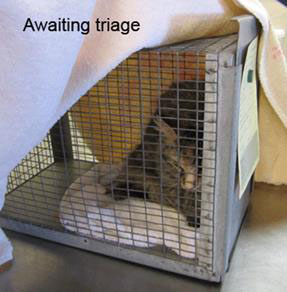
(See 2015 Final Report)
As for how it was in 2012 ...

What happens to a cat inside HAS depends on many factors, including how crowded the shelter is, the staffing level, whether the cat came in as a surrender or a stray and the condition of the cat on arrival. For a just-arrived cat, such as the one pictured below, it's usually a matter of first waiting in a cage in an entry area to be assessed by the Vet tech.
 If the cat arrives as a stray, he/she is checked for a microchip and, if one is found (and the contact info is current), the owner is notified and the lucky cat gets to go back home. Howevert, few arrive with ID, so most are, instead, examined for obvious injuries or illnesses, teeth are checked, age is estimated and behaviour/temperament issues are assessed. Then, in accordance with a procedure introduced early in 2012 to help keep the incoming cats healthy, the cat is also given an FVRCP vaccine booster in order to decrease susceptibility to several highly contagious diseases.
If the cat arrives as a stray, he/she is checked for a microchip and, if one is found (and the contact info is current), the owner is notified and the lucky cat gets to go back home. Howevert, few arrive with ID, so most are, instead, examined for obvious injuries or illnesses, teeth are checked, age is estimated and behaviour/temperament issues are assessed. Then, in accordance with a procedure introduced early in 2012 to help keep the incoming cats healthy, the cat is also given an FVRCP vaccine booster in order to decrease susceptibility to several highly contagious diseases.
Since many of the illnesses common in overcrowded shelters are air-borne, concerns are often raised about the need for more space to allow for segregation of especially vulnerable animals, such as kittens and pregnant cats, and isolation of sick ones). While there is a system for fresh air exchange , its adequacy is still questioned and the need for air conditioning (to improve the living conditions during the hot summer months) is a recurring (but still unaddressed) topic.
Following this initial assessment, the cat is assigned a cage in a designated area. This effort to segregate on intake is a newly introduced procedure that followed from a space realocation in 2012. According to that procedure, cats that need to be quarantined (for possible rabies, distemper, etc.) are assigned to a glassed-in locked area. Those that are evidently sick but treatable are placed in a room for ‘sick’ cats where they can receive medication or special care, Ones that appear well are assigned to another holding area. Intake/medical reports are attached to the cages and information about the cats is entered into the HAS data base. Since July 1, 2012, when HAS began partnering with www.helpinglostpets.com , a free ‘Lost and Found Pet Recovery website’, a photo of the cat is posted with info that is to be frequently updated.
With "kitten season" stretching from very early in the Spring to very late in the Fall, the reality is that periods of overcrowding occur, resulting in increased waits for triage and reduced options for segregation. So, the procedure described here is actually “an ideal” with lack of space potentially affecting all aspects of what actually happens to cats inside HAS.
With the continued decline in Intake during 2014, the #s inside have gone down, allowing for some changes, including rearrangement of cages (to reduce spread of disease and Shelter stress,) more staff time devoted to caring for sick/injured animals, and changing a room previously used as office space into an examining/treatment room thereby extending the capaciity for triage and vet services.
As part of a continuing effort to reduce the spread of disease, staff are instructed, when cleaning or tending to the cats, to go first into the areas where relatively healthy cats are housed and from there work their way to the areas where sick and quarantined cats are held. Procedures also call for hand washing after handling any cat or moving between rooms.
HAS continues to contract vet services for Shelter cats and for after hour emergency services.. With reduced Intake (and #s being euthanized) the budget allows , , for some additional vet supplies and, on occasion, for some treatments not previously available for sick/injured animals..
On to "A look at discharge at HAS" >>>
